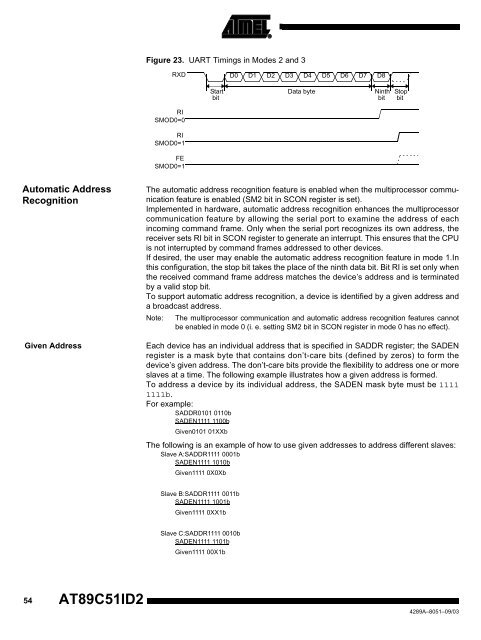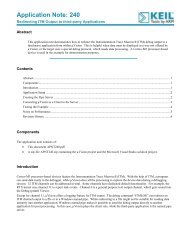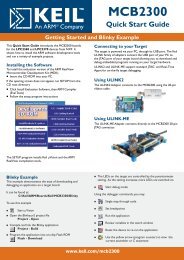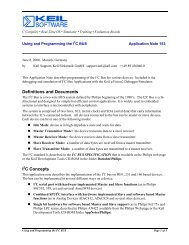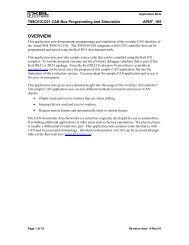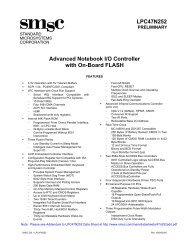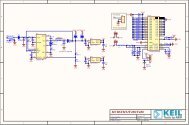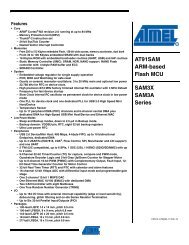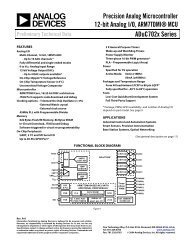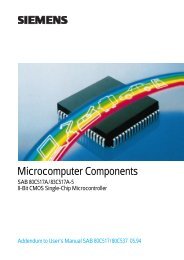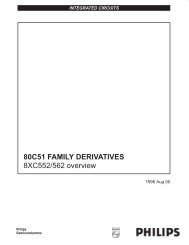You also want an ePaper? Increase the reach of your titles
YUMPU automatically turns print PDFs into web optimized ePapers that Google loves.
Automatic Address<br />
Recognition<br />
54 <strong>AT89C51ID2</strong><br />
Figure 23. UART Timings in Modes 2 and 3<br />
RI<br />
SMOD0=0<br />
RI<br />
SMOD0=1<br />
FE<br />
SMOD0=1<br />
RXD D0 D1 D2 D3 D4 D5 D6 D7 D8<br />
Start<br />
bit<br />
The automatic address recognition feature is enabled when the multiprocessor communication<br />
feature is enabled (SM2 bit in SCON register is set).<br />
Implemented in hardware, automatic address recognition enhances the multiprocessor<br />
communication feature by allowing the serial port to examine the address of each<br />
incoming command frame. Only when the serial port recognizes its own address, the<br />
receiver sets RI bit in SCON register to generate an interrupt. This ensures that the CPU<br />
is not interrupted by command frames addressed to other devices.<br />
If desired, the user may enable the automatic address recognition feature in mode 1.In<br />
this configuration, the stop bit takes the place of the ninth data bit. Bit RI is set only when<br />
the received command frame address matches the device’s address and is terminated<br />
by a valid stop bit.<br />
To support automatic address recognition, a device is identified by a given address and<br />
a broadcast address.<br />
Note: The multiprocessor communication and automatic address recognition features cannot<br />
be enabled in mode 0 (i. e. setting SM2 bit in SCON register in mode 0 has no effect).<br />
Given Address Each device has an individual address that is specified in SADDR register; the SADEN<br />
register is a mask byte that contains don’t-care bits (defined by zeros) to form the<br />
device’s given address. The don’t-care bits provide the flexibility to address one or more<br />
slaves at a time. The following example illustrates how a given address is formed.<br />
To address a device by its individual address, the SADEN mask byte must be 1111<br />
1111b.<br />
For example:<br />
SADDR0101 0110b<br />
SADEN1111 1100b<br />
Given0101 01XXb<br />
The following is an example of how to use given addresses to address different slaves:<br />
Slave A:SADDR1111 0001b<br />
SADEN1111 1010b<br />
Given1111 0X0Xb<br />
Slave B:SADDR1111 0011b<br />
SADEN1111 1001b<br />
Given1111 0XX1b<br />
Slave C:SADDR1111 0010b<br />
SADEN1111 1101b<br />
Given1111 00X1b<br />
<strong>Data</strong> byte Ninth<br />
bit<br />
Stop<br />
bit<br />
4289A–8051–09/03


